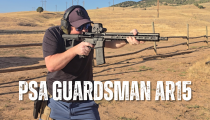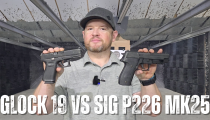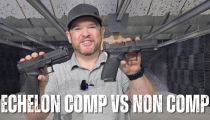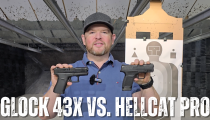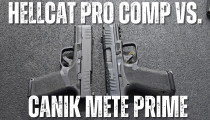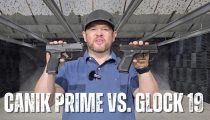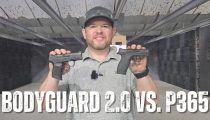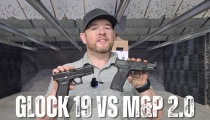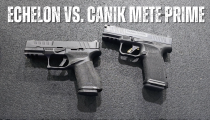Sig P365 XMACRO vs. Springfield Armory Hellcat Pro Comp
Get the Hellcat here: https://alnk.to/ei3OQoL
Get the XMACRO here: https://alnk.to/3U36Yic
Sig Sauer P365 XMACRO vs. Springfield Armory Hellcat Pro Comp: A Comprehensive Comparison
In the world of concealed carry firearms, the Sig Sauer P365 XMACRO and the Springfield Armory Hellcat Pro Comp stand out as two top contenders in the micro-compact 9mm category. Both pistols are designed to offer a balance of concealability, capacity, and performance, making them ideal for everyday carry (EDC). However, each brings unique features to the table, appealing to different preferences and priorities. This article provides an in-depth comparison of the two, covering their design, specifications, ergonomics, performance, and more to help you decide which is the better fit for your needs.
Overview
Sig Sauer P365 XMACRO
The Sig Sauer P365 XMACRO is a larger iteration of the highly popular P365 series, which revolutionized the micro-compact market in 2018 with its high capacity and small footprint. The XMACRO pushes the envelope further with a 17+1 round capacity, an integrated compensator (in some models), and a modular design that allows for customization. It’s marketed as one of the most concealable high-capacity pistols, blending compact dimensions with near-full-size performance.
Springfield Armory Hellcat Pro Comp
Introduced as an evolution of the original Hellcat, the Springfield Armory Hellcat Pro Comp builds on the success of its predecessor, which debuted in 2019 as a direct competitor to the P365. The Pro Comp variant features a 3.7-inch barrel, a 15+1 round capacity, and an integrated compensator for reduced recoil. It’s designed for concealed carry enthusiasts who want a slightly larger grip for better control while maintaining a slim profile.
Both pistols cater to the modern concealed carry market, offering high magazine capacities in compact packages. Let’s dive into the specifics to see how they stack up.
Specifications
Here’s a side-by-side comparison of the key specifications for the Sig Sauer P365 XMACRO and the Springfield Armory Hellcat Pro Comp:
|
Specification
|
Sig Sauer P365 XMACRO
|
Springfield Armory Hellcat Pro Comp
|
|---|---|---|
|
Caliber
|
9mm Parabellum
|
9mm Parabellum
|
|
Capacity
|
17+1 (standard flush-fit magazine)
|
15+1 (standard flush-fit magazine)
|
|
Barrel Length
|
3.1 inches (with integrated compensator)
|
3.7 inches (with integrated compensator)
|
|
Overall Length
|
6.6 inches
|
7.0 inches
|
|
Height
|
5.2 inches (with flush magazine)
|
4.8 inches (with flush magazine)
|
|
Width
|
1.4 inches (at controls)
|
1.1 inches (at grip)
|
|
Weight (Unloaded)
|
21.5 oz
|
21.0 oz
|
|
Sights
|
XRAY3 Day/Night Sights (optics-ready)
|
U-notch rear, luminescent front (optics-ready)
|
|
Trigger
|
Flat-faced, striker-fired
|
Flat blade, striker-fired
|
|
Frame Rail
|
Picatinny (standard)
|
Picatinny (standard)
|
|
Optics Compatibility
|
RMSc footprint (direct-mount capable)
|
RMSc footprint
|
|
MSRP (Approximate)
|
$799–$900 (varies by model)
|
$650–$750 (varies with promotions)
|
Key Takeaways:
-
The P365 XMACRO offers a higher capacity (17+1 vs. 15+1), which could be a deciding factor for those prioritizing firepower.
-
The Hellcat Pro Comp has a slightly longer barrel and overall length, which may enhance sight radius and accuracy but could make it marginally less concealable.
-
Both pistols are optics-ready and feature Picatinny rails, making them versatile for mounting lights or lasers.
-
The XMACRO is generally pricier, reflecting its modularity and premium features, while the Hellcat Pro Comp often comes with promotional bundles (e.g., extra magazines or optics) that can make it a better value.
Design and Build
Sig Sauer P365 XMACRO
The P365 XMACRO is a refined evolution of the P365 platform, featuring a larger grip module that accommodates a 17-round flush-fit magazine. Its modular chassis system allows users to swap grip modules, slides, and other components, making it highly customizable. The integrated compensator (available on some models, like the TACOPS) reduces muzzle flip, enhancing control during rapid fire. The XMACRO’s design is sleek, with front and rear slide serrations for easy manipulation and a flat-faced trigger that’s crisp and consistent. The grip texture is aggressive yet comfortable, and the pistol’s Picatinny rail supports a wide range of accessories.
Springfield Armory Hellcat Pro Comp
The Hellcat Pro Comp builds on the original Hellcat’s compact design with a slightly larger frame and a 3.7-inch barrel. The integrated compensator is cut into the slide, maintaining a compact profile while reducing recoil. The Hellcat’s Adaptive Grip Texture is notably grippy, extending high on the frame for better control, particularly for shooters with larger hands. The slide features full-wrap serrations, though some users find them less effective than the P365’s. The Hellcat Pro Comp’s U-notch rear sight and luminescent front sight are designed for quick target acquisition, and its optics-ready slide uses the RMSc footprint.
Design Comparison:
-
Ergonomics: The P365 XMACRO’s grip is slightly longer (by about 0.4 inches), which may improve control for shooters with larger hands but could make concealment trickier, especially for appendix carry. The Hellcat Pro Comp’s shorter grip height (4.8 inches) enhances concealability but may feel cramped for some.
-
Compensator: Both pistols feature integrated compensators, but the XMACRO’s design is often praised for better recoil management, making it feel flatter-shooting. The Hellcat Pro Comp’s compensator is effective but may not match the XMACRO’s performance in rapid fire.
-
Build Quality: The XMACRO’s finish and modularity give it a premium feel, though some users report magazine finish issues (e.g., susceptibility to rust). The Hellcat Pro Comp, made in Croatia by HS Produkt, has a robust build but lacks the same level of modularity.
Performance
Trigger
-
P365 XMACRO: The flat-faced trigger is a standout, offering a light take-up, minimal creep, and a clean, rolling break. Many shooters find it superior for precision shooting, with some claiming it’s among the best in the micro-compact class. The reset is positive but not as tactile as some competitors.
-
Hellcat Pro Comp: The Hellcat’s trigger is a flat-blade design with a short take-up and a predictable break, averaging around 5.5 pounds after break-in. However, some users report a “crunchy” feel compared to the smoother XMACRO trigger, and early models had issues with side pressure affecting performance (though improved in later versions).
Winner: The P365 XMACRO’s trigger is generally preferred for its consistency and smoothness, though trigger preference is subjective.
Accuracy
Both pistols are highly accurate for their size, but their longer barrels (compared to the standard P365 and Hellcat) and compensators enhance shootability:
-
P365 XMACRO: The combination of a crisp trigger, integrated compensator, and excellent XRAY3 sights makes the XMACRO exceptionally accurate, even at extended ranges (e.g., 25 yards). Its longer grip aids in recoil control, allowing for tighter shot groups during rapid fire.
-
Hellcat Pro Comp: The Hellcat’s 3.7-inch barrel provides a slightly longer sight radius, which can improve accuracy for some shooters. Its U-notch sight system is intuitive for quick target acquisition, though some prefer the P365’s three-dot setup. The Hellcat is slightly snappier in recoil, which may affect follow-up shots.
Winner: The P365 XMACRO edges out slightly due to its flatter shooting characteristics and superior trigger, but the Hellcat Pro Comp is no slouch and performs well in timed drills.
Reliability
Both pistols have proven reliable after initial teething issues with their respective platforms:
-
P365 XMACRO: Early P365 models had issues with striker drag and firing pin breakages, but these have been resolved in later generations, including the XMACRO. Users report thousands of rounds without malfunctions, though some note occasional light primer strikes with certain ammunition.
-
Hellcat Pro Comp: The Hellcat series has a strong reliability record, with fewer reported issues out of the gate compared to the early P365. Some aftermarket trigger modifications have caused light primer strikes, but stock models are dependable.
Winner: Tie. Both are reliable for EDC, with no significant issues in current production models.
Concealability and Ergonomics
Concealability
-
P365 XMACRO: Despite its higher capacity, the XMACRO’s 5.2-inch height and 1.4-inch width make it slightly harder to conceal than the Hellcat Pro Comp, particularly for appendix carry. The longer grip can print at certain angles, but its slim profile and rounded edges help mitigate this.
-
Hellcat Pro Comp: With a shorter height (4.8 inches) and narrower grip (1.1 inches), the Hellcat Pro Comp is slightly easier to conceal, especially for smaller-framed individuals or those using IWB holsters. Its compensator doesn’t significantly increase the overall length, keeping it compact.
Winner: Hellcat Pro Comp, by a small margin, due to its shorter grip height.
Ergonomics
-
P365 XMACRO: The longer grip module provides a full-hand purchase, improving control for shooters with average to large hands. The grip texture is aggressive but comfortable, and the modularity allows for customization to fit different hand sizes. However, some users with thick fingers find the grip slightly cramped.
-
Hellcat Pro Comp: The Hellcat’s grip is boxier and fills the hand well, particularly for those with larger hands. The Adaptive Grip Texture is highly effective, though some find it overly aggressive for extended range sessions. The thumb rest areas above the trigger guard enhance control.
Winner: Subjective. The XMACRO suits those who prefer a customizable, slightly longer grip, while the Hellcat Pro Comp is better for those who like a boxier, grippier feel.
Accessories and Customization
P365 XMACRO
The P365 platform’s modularity is a major selling point. The serialized chassis allows users to swap grip modules, slides, and barrels without needing a new firearm. Aftermarket support is extensive, with numerous holsters, grip modules, and optics options (e.g., Holosun 407K/507K, SIG Romeo Zero). The Picatinny rail supports a wide range of lights and lasers, and the 17-round magazines are reliable, though pricier than competitors (around $50–$60 each).
Hellcat Pro Comp
The Hellcat Pro Comp has solid aftermarket support, though not as extensive as the P365’s. Its Picatinny rail accommodates standard accessories, and the RMSc optics footprint supports popular micro red dots. Springfield’s magazines (15+1 and 13+1) are well-made and more affordable (around $29–$33). Promotional bundles often include extra magazines, range bags, or optics, adding value.
Winner: P365 XMACRO, due to its superior modularity and broader aftermarket ecosystem.
Price and Value
-
P365 XMACRO: With an MSRP of $799–$900, the XMACRO is pricier, reflecting its premium features like the compensator, high capacity, and modularity. Used or base P365 models can be found for $200–$300 less, but the XMACRO’s advanced features justify the cost for many.
-
Hellcat Pro Comp: Priced at $650–$750, the Hellcat Pro Comp is more affordable, especially with frequent promotions that include extra magazines or optics. For budget-conscious buyers, this makes it an attractive option.
Winner: Hellcat Pro Comp, for its lower price and promotional bundles, though the XMACRO’s features may justify the extra cost for some.
User Feedback and Community Sentiment
Feedback from online forums and reviews highlights the strengths and weaknesses of each pistol:
-
P365 XMACRO: Users praise its trigger, capacity, and modularity, with many preferring it for its shootability and recoil control. Some report discomfort with the grip for larger hands or note the higher cost of magazines. On platforms like Reddit, shooters often choose the XMACRO for its “better out-of-the-box experience.”
-
Hellcat Pro Comp: The Hellcat is lauded for its concealability, grip texture, and value, especially with promotional deals. However, some users dislike the trigger’s feel or find the pistol snappier than the XMACRO. Others appreciate the U-notch sights and ergonomics for quick draw scenarios.
Sentiment on X: Recent posts on X show a slight preference for the P365 XMACRO among users comparing it to other micro-compacts, citing its capacity and trigger. However, Hellcat Pro fans highlight its ergonomics and lower cost.
Pros and Cons
Sig Sauer P365 XMACRO
Pros:
-
Higher 17+1 capacity
-
Superior trigger feel and recoil management
-
Extensive modularity and aftermarket support
-
Flat-shooting with integrated compensator
-
Reliable after early platform issues resolved
Cons:
-
Slightly larger grip may hinder concealment
-
Higher price point
-
Magazines are expensive
Springfield Armory Hellcat Pro Comp
Pros:
-
More concealable due to shorter grip height
-
Lower price with frequent promotional bundles
-
Excellent grip texture and ergonomics for larger hands
-
Reliable with strong aftermarket support
-
Intuitive U-notch sights
Cons:
-
Lower 15+1 capacity
-
Trigger can feel “crunchy” compared to XMACRO
-
Less modular than the P365 platform
Conclusion: Which Is Right for You?
Choosing between the Sig Sauer P365 XMACRO and the Springfield Armory Hellcat Pro Comp depends on your priorities:
-
Choose the P365 XMACRO if you value higher magazine capacity (17+1), a smoother trigger, and extensive modularity for customization. It’s ideal for shooters who prioritize shootability and are willing to pay a premium for premium features. The XMACRO excels for those who want a versatile EDC that feels like a larger pistol while remaining concealable.
-
Choose the Hellcat Pro Comp if you prioritize concealability, affordability, and value-driven bundles. Its shorter grip and lower price make it a great choice for budget-conscious buyers or those with smaller frames who need a more concealable option. The Hellcat’s ergonomics and sights appeal to those who value quick draw and intuitive handling.
Both pistols are excellent choices for concealed carry, offering high capacity, reliability, and modern features. The best way to decide is to handle and shoot both at a range, as personal fit and feel are critical in choosing an EDC firearm. If possible, consider factors like holster availability, accessory compatibility, and your budget when making your decision.
Happy shooting!


